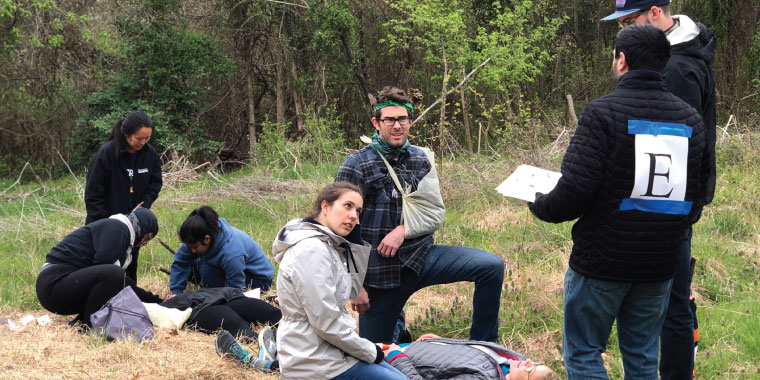Emergency Medicine Club

Anastasia Ambrosio loves emergency medicine (EM), and she even brings a sense of urgency to her passion. She enthusiastically describes hands-on clinics, speakers from the ER frontlines, and a paintball tournament triage, all organized by the KCU-Kansas City Emergency Medicine Club (EMC). A second-year med student, she serves as the club’s president and also class secretary of the College of Osteopathic Medicine (COM) Class of 2021.
“Our goal is to give students a lot of exposure about how much you can do in emergency medicine, to help students realize where they might want to go with their career,” she says. “I want to help them see how big, how awesome emergency medicine is.”
Ambrosio has organized opportunities for her fellow students to learn skills, to hear about specialties within EM and to talk with speakers about what it takes to get into the world of emergency medicine.
Stephanie Davis, DO, the club’s alumni advisor and an EM physician with Saint Luke’s Health System Kansas City, agrees.
“There is only minimal exposure to each specialty in medical school,” noted Davis. “The KCU clubs give students the opportunity to have several exposures and interactions with physicians in their specialty to ensure they are going to be happy with their career choice. It is helpful to have a glimpse of what life will be like ‘on the other side’”.
Ambrosio and other club members have learned how EM and critical care physicians are using telecommunications and video conferencing tools like Skype to “get a top-notch doctor advising the ER staff.” They’ve listened to doctors who specialize in wilderness medicine describe their experiences – “what to do when all you have is an Ace bandage and a splint,” she says. And they’ve been able to learn from residents about fellowships and the nitty-gritty ins and outs of an EM residency.
The club’s interactive experiences complement speaker forums. For example, EMC has run clinics that taught specific emergency procedures such as chest tubes, intubations, needle decompressions and sutures. They even had the opportunity to work with cadavers – “It was cool to work on real tissue.”
Thanks to Davis’ connections, several students participated in a mass casualty simulation put on by the City of Chicago. The scenario was a simulated bomb incident, and the student volunteers were among the injured. “They bloodied us up and the doctors had to come and treat us,” Ambrosio recalls.
Committed to both camaraderie and exposure to the profession, Ambrosio describes an upcoming “medical paintball” activity for 120 first- and second-year students. She says the real-time experience will offer student teams tactical training in a fun environment. “We’ll see what injuries come up in a combat-like zone. We’ll do triage. We’ll run through the steps to treat patients immediately.”
In addition to sub-specialties and technical skills, Ambrosio also thinks it is important to understand the lifestyle aspects of an emergency medicine specialist.
Davis also notes the relationship aspect of the EMC and other student clubs. “Networking is invaluable once a student graduates and is moving on to residency and eventually a career as a physician, and early networking improves the chances for success,” she says. Developing a support system of friends and colleagues is intensely vital to long-term survival and wellness as a physician. “This is something that cannot be obtained through podcasts, online learning or lectures.”